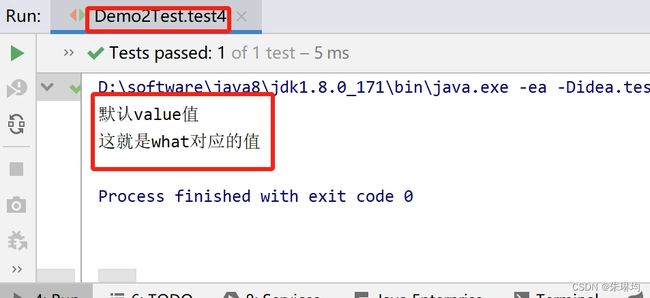springmvc之自定义注解-->自定义注解简介,基本案例和aop自定义注解
- 自定义注解简介
- 自定义注解基本案例
- aop自定义注解
1.自定义注解简介
1.基本注解
2.元注解
3.自定义注解
3.1.标记注解
3.2.元数据注解
3.3.自定义注解语法:@interface
JDK基本注解
@Override
重写@SuppressWarnings(value = "unchecked")
压制编辑器警告
JDK元注解
@Retention:定义注解的保留策略
@Retention(RetentionPolicy.SOURCE) //注解仅存在于源码中,在class字节码文件中不包含
@Retention(RetentionPolicy.CLASS) //默认的保留策略,注解会在class字节码文件中存在,但运行时无法获得,
@Retention(RetentionPolicy.RUNTIME) //注解会在class字节码文件中存在,在运行时可以通过反射获取到@Target:指定被修饰的Annotation可以放置的位置(被修饰的目标)
@Target(ElementType.TYPE) //接口、类
@Target(ElementType.FIELD) //属性
@Target(ElementType.METHOD) //方法
@Target(ElementType.PARAMETER) //方法参数
@Target(ElementType.CONSTRUCTOR) //构造函数
@Target(ElementType.LOCAL_VARIABLE) //局部变量
@Target(ElementType.ANNOTATION_TYPE) //注解
@Target(ElementType.PACKAGE) //包
注:可以指定多个位置,例如:
@Target({ElementType.METHOD, ElementType.TYPE}),也就是此注解可以在方法和类上面使用@Inherited:指定被修饰的Annotation将具有继承性
@Documented:指定被修饰的该Annotation可以被javadoc工具提取成文档.
自定义注解
注解分类(根据Annotation是否包含成员变量,可以把Annotation分为两类):
标记Annotation:
没有成员变量的Annotation; 这种Annotation仅利用自身的存在与否来提供信息元数据Annotation:
包含成员变量的Annotation; 它们可以接受(和提供)更多的元数据;
如何自定义注解?
使用@interface关键字, 其定义过程与定义接口非常类似, 需要注意的是:
Annotation的成员变量在Annotation定义中是以无参的方法形式来声明的, 其方法名和返回值类型定义了该成员变量的名字和类型,
而且我们还可以使用default关键字为这个成员变量设定默认值;
2.自定义注解基本案例
案例一
//pom.xml
4.0.0
org.example
zljzyssm
1.0-SNAPSHOT
war
zljzyssm Maven Webapp
http://www.example.com
UTF-8
1.8
1.8
3.7.0
5.0.2.RELEASE
3.4.5
5.1.44
5.1.2
1.3.1
2.1.1
2.4.3
2.9.1
3.2.0
1.7.13
4.12
4.0.0
1.18.2
1.1.0
2.10.0
2.9.0
1.7.1.RELEASE
2.9.3
1.2
1.1.2
8.0.47
1.3.3
5.0.2.Final
1.3.2
org.springframework
spring-core
${spring.version}
org.springframework
spring-beans
${spring.version}
org.springframework
spring-context
${spring.version}
org.springframework
spring-orm
${spring.version}
org.springframework
spring-tx
${spring.version}
org.springframework
spring-aspects
${spring.version}
org.springframework
spring-web
${spring.version}
org.springframework
spring-test
${spring.version}
org.mybatis
mybatis
${mybatis.version}
mysql
mysql-connector-java
${mysql.version}
com.github.pagehelper
pagehelper
${pagehelper.version}
org.mybatis
mybatis-spring
${mybatis.spring.version}
org.springframework
spring-context-support
${spring.version}
org.mybatis.caches
mybatis-ehcache
${mybatis.ehcache.version}
net.sf.ehcache
ehcache
${ehcache.version}
redis.clients
jedis
${redis.version}
org.springframework.data
spring-data-redis
${redis.spring.version}
com.fasterxml.jackson.core
jackson-databind
${jackson.version}
com.fasterxml.jackson.core
jackson-core
${jackson.version}
com.fasterxml.jackson.core
jackson-annotations
${jackson.version}
org.apache.commons
commons-dbcp2
${commons.dbcp2.version}
commons-pool2
org.apache.commons
org.apache.commons
commons-pool2
${commons.pool2.version}
org.springframework
spring-webmvc
${spring.version}
org.slf4j
slf4j-api
${slf4j.version}
org.slf4j
jcl-over-slf4j
${slf4j.version}
runtime
org.apache.logging.log4j
log4j-api
${log4j2.version}
org.apache.logging.log4j
log4j-core
${log4j2.version}
org.apache.logging.log4j
log4j-slf4j-impl
${log4j2.version}
org.apache.logging.log4j
log4j-web
${log4j2.version}
runtime
com.lmax
disruptor
${log4j2.disruptor.version}
junit
junit
${junit.version}
javax.servlet
javax.servlet-api
${servlet.version}
provided
org.projectlombok
lombok
${lombok.version}
provided
jstl
jstl
${jstl.version}
taglibs
standard
${standard.version}
org.apache.tomcat
tomcat-jsp-api
${tomcat-jsp-api.version}
commons-fileupload
commons-fileupload
${commons-fileupload.version}
org.hibernate
hibernate-validator
${hibernate-validator.version}
org.apache.shiro
shiro-core
${shiro.version}
org.apache.shiro
shiro-web
${shiro.version}
org.apache.shiro
shiro-spring
${shiro.version}
zljzyssm
src/main/java
**/*.xml
src/main/resources
jdbc.properties
*.xml
org.apache.maven.plugins
maven-compiler-plugin
${maven.compiler.plugin.version}
${maven.compiler.source}
${maven.compiler.target}
${project.build.sourceEncoding}
org.mybatis.generator
mybatis-generator-maven-plugin
1.3.2
mysql
mysql-connector-java
${mysql.version}
true
package com.zlj.annotation.demo1;
public enum TranscationModel {
Read, Write, ReadWrite;
private String name;
private Integer id;
public void init1(){
Read.id=1;
Read.name="zs";
}
public void init2(){
Write.id=2;
Write.name="ls";
}
public void init3(){
ReadWrite.id=3;
ReadWrite.name="ww";
}
}
package com.zlj.annotation.demo1;
import java.lang.annotation.*;
/**
* MyAnnotation1注解可以用在类、接口、属性、方法上
* 注解运行期也保留
* 不可继承
*/
@Target({ElementType.TYPE, ElementType.FIELD,ElementType.METHOD})
@Retention(RetentionPolicy.RUNTIME)
@Documented
public @interface MyAnnotation1 {
String name();
}package com.zlj.annotation.demo1;
import java.lang.annotation.*;
/**
* MyAnnotation2注解可以用在方法上
* 注解运行期也保留
* 不可继承
*/
@Target(ElementType.METHOD)
@Retention(RetentionPolicy.RUNTIME)
@Documented
public @interface MyAnnotation2 {
TranscationModel model() default TranscationModel.ReadWrite;
}package com.zlj.annotation.demo1;
import java.lang.annotation.*;
/**
* MyAnnotation3注解可以用在方法上
* 注解运行期也保留
* 可继承
*/
@Target(ElementType.METHOD)
@Retention(RetentionPolicy.RUNTIME)
@Inherited //继承使用时需要该注解,否则读取不到该继承的注解及属性
@Documented
public @interface MyAnnotation3 {
TranscationModel[] models() default TranscationModel.ReadWrite;
}package com.zlj.annotation;
import com.zlj.annotation.demo1.TranscationModel;
/**
* @author zlj
* @create 2023-09-14 19:32
*/
public class Test1 {
public static void main(String[] args) {
System.out.println(TranscationModel.Read);
System.out.println(TranscationModel.Write);
System.out.println(TranscationModel.ReadWrite);
}
}
package com.zlj.annotation;
import com.zlj.annotation.demo1.MyAnnotation1;
import com.zlj.annotation.demo1.MyAnnotation2;
import com.zlj.annotation.demo1.MyAnnotation3;
import com.zlj.annotation.demo1.TranscationModel;
/**
*
* 获取类与方法上的注解值
*/
@MyAnnotation1(name = "abc")
public class Demo1 {
@MyAnnotation1(name = "xyz")
private Integer age;
@MyAnnotation2(model = TranscationModel.Read)
public void list() {
System.out.println("list");
}
@MyAnnotation3(models = {TranscationModel.Read, TranscationModel.Write})
public void edit() {
System.out.println("edit");
}
}
package com.zlj.annotation;
import com.zlj.annotation.demo1.MyAnnotation1;
import com.zlj.annotation.demo1.MyAnnotation2;
import com.zlj.annotation.demo1.MyAnnotation3;
import com.zlj.annotation.demo1.TranscationModel;
import org.junit.Test;
/**
* @site www.javaxl.com
*/
public class Demo1Test {
@Test
public void list() throws Exception {
// 获取类上的注解
MyAnnotation1 annotation1 = Demo1.class.getAnnotation(MyAnnotation1.class);
System.out.println(annotation1.name());//abc
// 获取方法上的注解
MyAnnotation2 myAnnotation2 = Demo1.class.getMethod("list").getAnnotation(MyAnnotation2.class);
System.out.println(myAnnotation2.model());//Read
// 获取属性上的注解
MyAnnotation1 myAnnotation1 = Demo1.class.getDeclaredField("age").getAnnotation(MyAnnotation1.class);
System.out.println(myAnnotation1.name());// xyz
}
@Test
public void edit() throws Exception {
MyAnnotation3 myAnnotation3 = Demo1.class.getMethod("edit").getAnnotation(MyAnnotation3.class);
for (TranscationModel model : myAnnotation3.models()) {
System.out.println(model);//Read,Write
}
}
}
案例二
package com.zlj.annotation.demo2;
/**
* @site www.javaxl.com
*
* 获取类属性上的注解属性值
*/
public class Demo2 {
@TestAnnotation(value = "这就是value对应的值_msg1", what = "这就是what对应的值_msg1")
private static String msg1;
//当没有在注解中指定属性名,那么就是value
@TestAnnotation("这就是value对应的值1")
private static String msg2;
@TestAnnotation(value = "这就是value对应的值2")
private static String msg3;
@TestAnnotation(what = "这就是what对应的值")
private static String msg4;
}package com.zlj.annotation.demo2;
import java.lang.annotation.ElementType;
import java.lang.annotation.Retention;
import java.lang.annotation.RetentionPolicy;
import java.lang.annotation.Target;
/**
* @site www.javaxl.com
*/
//@Retention(RetentionPolicy.SOURCE)
@Retention(RetentionPolicy.RUNTIME)
@Target(ElementType.FIELD)
public @interface TestAnnotation {
String value() default "默认value值";
String what() default "这里是默认的what属性对应的值";
}
package com.zlj.annotation.demo2;
import org.junit.Test;
/**
* @site www.javaxl.com
*/
public class Demo2Test {
@Test
public void test1() throws Exception {
TestAnnotation msg1 = Demo2.class.getDeclaredField("msg1").getAnnotation(TestAnnotation.class);
System.out.println(msg1.value());
System.out.println(msg1.what());
}
@Test
public void test2() throws Exception{
TestAnnotation msg2 = Demo2.class.getDeclaredField("msg2").getAnnotation(TestAnnotation.class);
System.out.println(msg2.value());
System.out.println(msg2.what());
}
@Test
public void test3() throws Exception{
TestAnnotation msg3 = Demo2.class.getDeclaredField("msg3").getAnnotation(TestAnnotation.class);
System.out.println(msg3.value());
System.out.println(msg3.what());
}
@Test
public void test4() throws Exception{
TestAnnotation msg4 = Demo2.class.getDeclaredField("msg4").getAnnotation(TestAnnotation.class);
System.out.println(msg4.value());
System.out.println(msg4.what());
}
}
总结:在Demo2中如果指定了value和what值,那么在DemoTest2运行结果就是Demo2里的value和what值;
在Demo2中如果没有在注解中指定属性名,那么就是value,在DemoTest2运行结果就是Demo2的value值和TestAnnotation里的what值;
在Demo2中如果只指定了value值,在DemoTest2运行结果也是Demo2的value值和TestAnnotation里的what值;
在Demo2中如果只指定了what值,在DemoTest2运行结果就是TestAnnotation里的value值和Demo2的what值;
方案三
package com.zlj.annotation.demo3;
import java.lang.annotation.*;
/**
* @author zlj
* @site www.javaxl.com
*
* 非空注解:使用在方法的参数上,false表示此参数可以为空,true不能为空
*/
@Documented
@Target({ElementType.PARAMETER})
@Retention(RetentionPolicy.RUNTIME)
public @interface IsNotNull {
boolean value() default false;
}package com.zlj.annotation.demo3;
/**
* @author zlj
* @site www.javaxl.com
*
* 获取参数修饰注解对应的属性值
*/
public class Demo3 {
public void hello1(@IsNotNull(true) String name) {
System.out.println("hello:" + name);
}
public void hello2(@IsNotNull String name) {
System.out.println("hello:" + name);
}
}package com.zlj.annotation.demo3;
import org.junit.Test;
import java.lang.reflect.Method;
import java.lang.reflect.Parameter;
/**
* @author zlj
* @site www.javaxl.com
*/
public class Demo3Test {
@Test
public void hello1() throws Exception {
Demo3 demo3 = new Demo3();
for (Parameter parameter : demo3.getClass().getMethod("hello1", String.class).getParameters()) {
IsNotNull annotation = parameter.getAnnotation(IsNotNull.class);
if(annotation != null){
System.out.println(annotation.value());//true
}
}
}
@Test
public void hello2() throws Exception {
Demo3 demo3 = new Demo3();
for (Parameter parameter : demo3.getClass().getMethod("hello2", String.class).getParameters()) {
IsNotNull annotation = parameter.getAnnotation(IsNotNull.class);
if(annotation != null){
System.out.println(annotation.value());//false
}
}
}
@Test
public void hello3() throws Exception {
// 模拟浏览器传递到后台的参数 解读@requestParam
String name = "zs";
Demo3 demo3 = new Demo3();
Method method = demo3.getClass().getMethod("hello1", String.class);
for (Parameter parameter : method.getParameters()) {
IsNotNull annotation = parameter.getAnnotation(IsNotNull.class);
if(annotation != null){
System.out.println(annotation.value());//true
if (annotation.value() && !"".equals(name)){
method.invoke(demo3,name);
}
}
}
}
}注解案例知识点:
1.获取类,方法,属性,修饰参数上的注解
2.关于注解上的value属性设置值是可以省略的
3.Inhereted案例演示,体现类上面的注解的继承性
4.default值的使用
3.aop自定义注解
package com.zlj.annotation.aop;
import java.lang.annotation.ElementType;
import java.lang.annotation.Retention;
import java.lang.annotation.RetentionPolicy;
import java.lang.annotation.Target;
/**
* @author zlj
* @site www.javaxl.com
*/
@Target(ElementType.METHOD)
@Retention(RetentionPolicy.RUNTIME)
public @interface MyLog {
String desc();
}package com.zlj.web;
import com.zlj.annotation.aop.MyLog;
import org.springframework.stereotype.Controller;
import org.springframework.web.bind.annotation.RequestMapping;
/**
* @author zlj
* @site www.javaxl.com
*/
@Controller
public class LogController {
@RequestMapping("/mylog")
@MyLog(desc = "这是结合spring aop知识,讲解自定义注解应用的一个案例")
public void testLogAspect(){
System.out.println("这里随便来点啥");
}
}
package com.zlj.aspect;
import com.zlj.annotation.aop.MyLog;
import org.aspectj.lang.JoinPoint;
import org.aspectj.lang.annotation.Aspect;
import org.aspectj.lang.annotation.Before;
import org.aspectj.lang.annotation.Pointcut;
import org.aspectj.lang.reflect.MethodSignature;
import org.slf4j.Logger;
import org.slf4j.LoggerFactory;
import org.springframework.stereotype.Component;
/**
* @author zlj
* @site www.javaxl.com
*/
@Component
@Aspect
public class MyLogAspect {
private static final Logger logger = LoggerFactory.getLogger(MyLogAspect.class);
/**
* 只要用到了com.javaxl.p2.annotation.springAop.MyLog这个注解的,就是目标类
* * *..Biz. *pager(..)
* execution
*/
@Pointcut("@annotation(com.zlj.annotation.aop.MyLog)")
private void MyValid() {
}
@Before("MyValid()")
public void before(JoinPoint joinPoint) {
MethodSignature signature = (MethodSignature) joinPoint.getSignature();
logger.debug("[" + signature.getName() + " : start.....]");
System.out.println("[" + signature.getName() + " : start.....]");
MyLog myLog = signature.getMethod().getAnnotation(MyLog.class);
logger.debug("【目标对象方法被调用时候产生的日志,记录到日志表中】:"+myLog.desc());
System.out.println("【目标对象方法被调用时候产生的日志,记录到日志表中】:" + myLog.desc());
}
}



